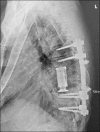Management of autonomic dysreflexia associated with Charcot spinal arthropathy in a patient with complete spinal cord injury: Case report and review of the literature
- PMID: 29930879
- PMCID: PMC5991269
- DOI: 10.4103/sni.sni_287_17
Management of autonomic dysreflexia associated with Charcot spinal arthropathy in a patient with complete spinal cord injury: Case report and review of the literature
Abstract
Background: Charcot spinal arthropathy (CSA) clearly represents a challenge in long-term spinal cord injury patients, one that can have extremely uncomfortable and potentially lethal outcomes if not managed properly.
Case description: A 66-year-old man with a history of complete C7 quadriplegia presented with new-onset autonomic dysreflexia that resulted from Charcot spinal arthropathy (CSA). Pathologic instability, in the atypical site of the mid-thoracic spine, spanning from the T8-T9 vertebral levels was appreciated on physical exam as an audible, palpable, and visible dynamic kyphosis; kyphosis was later confirmed on neuroimaging. Based on the CSA severity and sequelae, the patient underwent bilateral decompression laminectomy with lateral extracavitary arthrodesis and posterior instrumentation. Symptoms dramatically improved and at 1-year follow-up, dynamic thoracic kyphosis and most symptoms of autonomic dysreflexia had resolved.
Conclusions: Based on our case and published reports, vigilant imaging and thorough physical examination in long-standing spinal cord injury could help early diagnosis and treatment of CSA, theoretically preventing development of cord atrophy and subsequent long-term sequelae. Surgical correction rather than bracing may be recommended in patients who have complete injury at or above T6 in patients with symptoms of autonomic dysreflexia associated with CSA confirmed on neuroimaging.
Keywords: Charcot spine; complications; long-term spinal cord injury; neuropathic spinal arthropathy; spinal neuroarthropathy.
Conflict of interest statement
There are no conflicts of interest.
Figures



Similar articles
-
Four-rod Instrumentation for Treatment of Charcot Spinal Arthropathy Causing Autonomic Dysreflexia: Case Report and Literature Review.Cureus. 2016 Oct 27;8(10):e850. doi: 10.7759/cureus.850. Cureus. 2016. PMID: 27909638 Free PMC article.
-
Charcot arthropathy in relation to autonomic dysreflexia in spinal cord injury: case report and review of the literature.J Neurosurg Spine. 2005 Apr;2(4):476-80. doi: 10.3171/spi.2005.2.4.0476. J Neurosurg Spine. 2005. PMID: 15871489 Review.
-
Charcot Spinal Arthropathy Secondary to Spinal Cord Injury - A Case Report.J Orthop Case Rep. 2025 Mar;15(3):140-145. doi: 10.13107/jocr.2025.v15.i03.5364. J Orthop Case Rep. 2025. PMID: 40092268 Free PMC article.
-
Posttraumatic Charcot (Neuropathic) Spinal Arthropathy at the Cervicothoracic Junction.World Neurosurg. 2016 Oct;94:580.e1-580.e4. doi: 10.1016/j.wneu.2016.07.064. Epub 2016 Jul 26. World Neurosurg. 2016. PMID: 27474457
-
Autonomic dysreflexia associated with Charcot spine following spinal cord injury: a case report and literature review.Eur Spine J. 2010 Jul;19 Suppl 2(Suppl 2):S179-82. doi: 10.1007/s00586-010-1296-y. Epub 2010 Feb 4. Eur Spine J. 2010. PMID: 20130931 Free PMC article. Review.
Cited by
-
Cerebrospinal fluid-cutaneous fistula associated with post-traumatic Charcot spinal arthropathy: a case report and review of literature.BMC Musculoskelet Disord. 2020 Jun 29;21(1):412. doi: 10.1186/s12891-020-03451-7. BMC Musculoskelet Disord. 2020. PMID: 32600397 Free PMC article. Review.
-
Discitis following urinary tract infection manifesting as recurrent autonomic dysreflexia related to truncal movements in a person with tetraplegia.BMJ Case Rep. 2020 Dec 17;13(12):e238202. doi: 10.1136/bcr-2020-238202. BMJ Case Rep. 2020. PMID: 33334762 Free PMC article.
-
Surgical management of a complex case of Charcot arthropathy of the spine: a case report.Spinal Cord Ser Cases. 2019 Aug 22;5:73. doi: 10.1038/s41394-019-0217-5. eCollection 2019. Spinal Cord Ser Cases. 2019. PMID: 31632731 Free PMC article.
-
A comparative study of L4-L5-S1 and L5-S1 vertebral fusion in high-grade L5-S1 spondylolisthesis.J Craniovertebr Junction Spine. 2021 Apr-Jun;12(2):202-208. doi: 10.4103/jcvjs.jcvjs_41_21. Epub 2021 Jun 10. J Craniovertebr Junction Spine. 2021. PMID: 34194169 Free PMC article.
References
-
- Arnold JM, Feng QP, Delaney GA, Teasell RW. Autonomic dysreflexia in tetraplegic patients: Evidence for alpha-adrenoceptor hyper-responsiveness. Clin Auton Res. 1995;5:267–70. - PubMed
-
- Baker N, Green A, Krishnan S, Rayman G. Microvascular and C-fiber function in diabetic charcot neuroarthropathy and diabetic peripheral neuropathy. Diabetes Care. 2007;30:3077–9. - PubMed
-
- Barrey C, Massourides H, Cotton F, Perrin G, Rode G. Charcot spine: Two new case reports and a systematic review of 109 clinical cases from the literature. Ann Phys Rehabil Med. 2010;53:200–20. - PubMed
-
- Beard JP, Wade WH, Barber DB. Sacral insufficiency stress fracture as etiology of positional autonomic dysreflexia: Case report. Paraplegia. 1996;34:173–5. - PubMed
-
- Bloch R. Autonomic dysfunction in management of spinal cord. In: Bloch RF, Basbaum M, editors. Management of Spinal Cord Injuries. Baltimore, MD: Williams and Wilkins; 1986. pp. 149–63.
Publication types
LinkOut - more resources
Full Text Sources
Other Literature Sources
Miscellaneous
